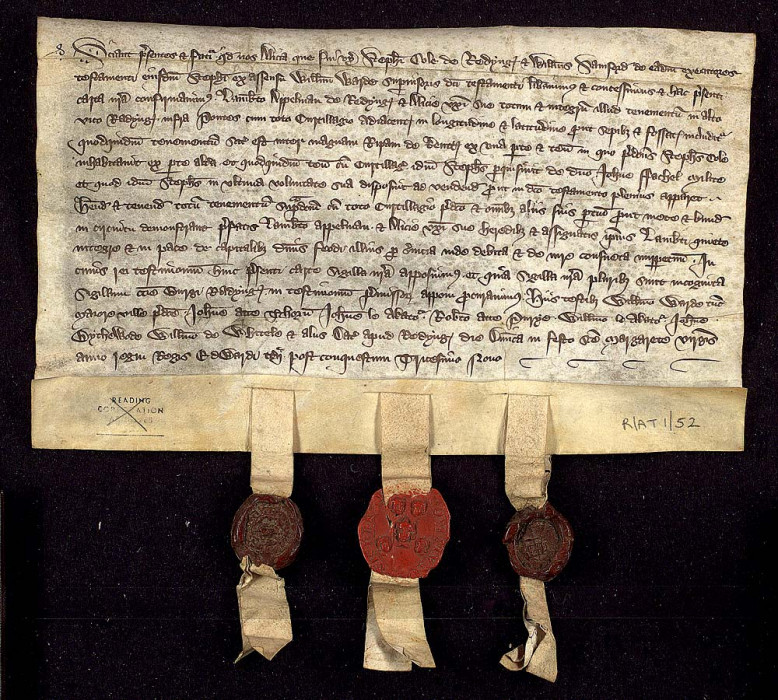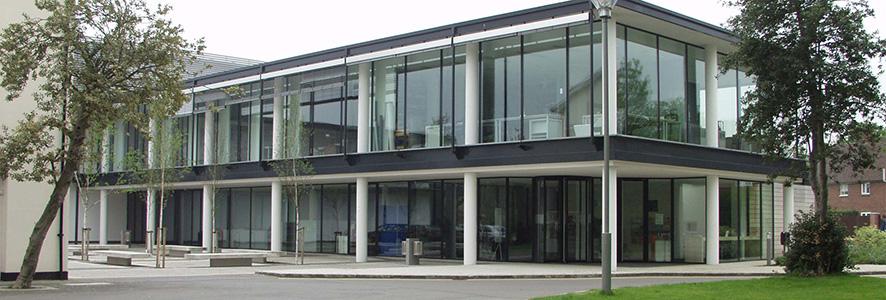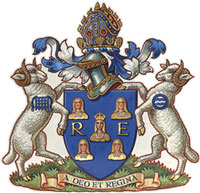
In 2003, Reading celebrated the 750th anniversary of the grant of its first royal charter, and therefore of self-government. Click on the links to see more about the history of Reading, and to see some of the Borough's charters and other documents.
Downloads
PDF Souvenir Poster from the Charter 750 Exhibition
There are two mentions of Reading in the Anglo-Saxon Chronicle. The first is in 870, when King Alfred fought the Danes who were camped there. Reading is mentioned again in 1006 as a town that the Danes burnt. It is probable that the name Reading came from a group whose leader was someone nicknamed Reada, or Red.
When the Domesday Book was compiled in 1086, the principal landowners in Reading were the King and the Abbot of Battle Abbey in Sussex. The description of the King’s property includes some within the ‘borough of Reading’. This description supports the argument of the Merchant Gild that the town enjoyed chartered status long before the creation of the Abbey.
Reading at Domesday was a town of around 60 households. The county town of Berkshire was Wallingford, with its own castle and around 500 households. Reading was also of much lesser importance than Abingdon, with its Benedictine Abbey, and a similar size to Newbury and Windsor.
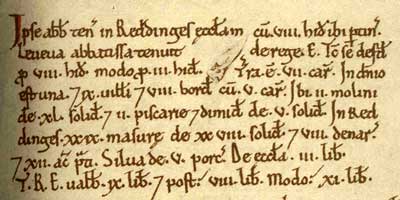
Domesday Book: The Abbot of Battle’s holdings in Reading (reproduced by permission of Alecto Historical Editions)
Reading at Domesday was a town of around 60 households. The county town of Berkshire was Wallingford, with its own castle and around 500 households. Reading was also of much lesser importance than Abingdon, with its Benedictine Abbey, and a similar size to Newbury and Windsor.
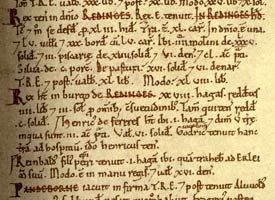
Domesday Book: the King’s holdings in Reading (reproduced by permission of Alecto Historical Editions)
Reading Abbey was founded by Henry I in 1121. The Abbey immediately acquired not just the town but enormous privileges to hold courts and fairs and control trade.
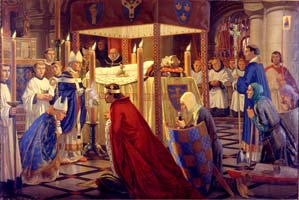
The Burial of Henry I, by Stephen Reid 1916 (reproduced by permission of The Museum of Reading)
The traders and craftsmen in the town had formed a Merchant Gild to manage their lands and their own, separate market. When the Abbey needed money it tried to take over the market. The Gild petitioned the King to claim borough rights and freedoms which pre-dated the Abbey’s rights. But the Gild could produce no written evidence to prove this.
So the Gild paid £100 (roughly £44,000 at today’s prices) for the grant by the King of the charter of 5 July 1253, giving them freedom to buy and sell wheresoever they wished throughout England without tolls. This is the earliest such grant of rights to what became the town of Reading.
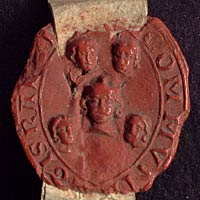
The earliest representation of the Borough’s arms on the town seal 1365 (R/AT1/52)
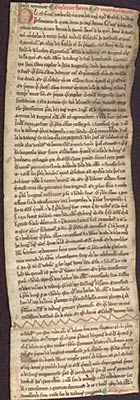
A contemporary copy of the 1254 agreement between the Abbot and the Merchant Gild (R/HMC IIIpt)
The Gild also made an agreement with the Abbot in February 1254. This agreement defined the relationship between town and Abbey until the Dissolution. It allowed the burgesses of the Gild to keep their market, their Gildhall and other properties; in return the Abbot received a financial contribution from the Gild and could collect the fines from the court.
The Dissolution of Reading Abbey in 1539 left a power vacuum in the town. So in 1542 Henry VIII granted the first charter specifically to set up the Merchant Gild as a Corporation to run Reading. They could hold property, run the market, issue warrants and have a jail.
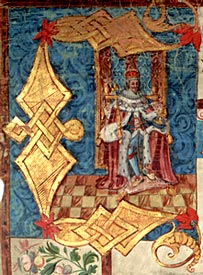
Charles I’s portrait initial on the 1638 charter (R/IC1/10)
Subsequent charters amplified the Corporation’s powers. Elizabeth I’s charter of 1560 allowed the Corporation to buy land, make byelaws, run the Grammar School and repair the town’s bridges. This charter also granted the Abbey’s estates to the Corporation, and for the first time defined the town boundaries.
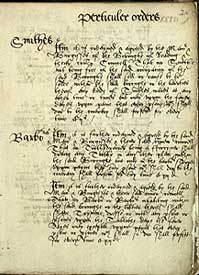
'Perticuler orders' for smiths and barbers: from the ordinances of the cutlers and bellfounders company c1555 (R/AG1/2)
Charles I’s charter of 1638 granted Reading its own criminal court of quarter sessions and a coroner. It also allowed the Corporation to levy rates and oversee pub licensing, as well as providing the first planning regulations with fines for building roofs of thatch or subdividing dwellings.
This charter also provided for the Corporation’s management of the town’s charities. Some of these charities were substantial. John Kendrick, a wealthy cloth trader, had bequeathed money in 1624 for the Oracle workhouse for clothworking as well as money for education that survives today as Kendrick School.
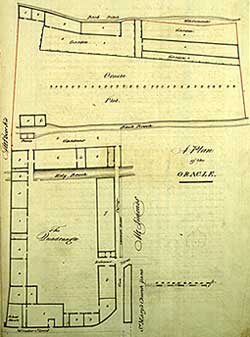
Plan of the Oracle workhouse 1807 (R/578)
By 1835 Reading had changed from being a town of plaster and thatch to being a town of brick and tile.
But the old Corporation remained a body concerned more with managing assets and trade than providing services to the general population. What additional local services there were since 1638 - paving, lighting, the watch, water and gas - had been provided either by special bodies set up by Parliament or by private companies.
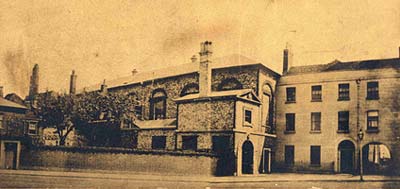
Photograph of the original 1786 Town Hall building circa 1860 (reproduced by permission of Reading Library Service)
The Municipal Corporations Act 1835 reformed England’s ‘rotten boroughs’ and gave the power of electing a new Council to a significant number of Reading’s 17,000 inhabitants. Although the only direct new power given to the Corporation was to establish a Borough Police Force, during the next 50 years it also became the Local Board of Health with powers over sewerage and drainage (1850); set up a fire brigade (1862); and opened a library and museum (1882). After the Education Act 1870 the Borough also established the Reading School Board to manage elementary school provision across the Borough.
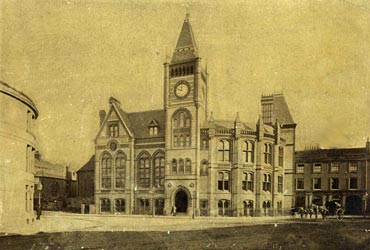
Photograph of Alfred Waterhouse’s extension to the Town Hall circa 1880 (reproduced by permission of Reading Library Service)
Reading’s population increased to around 60,000 after the Borough boundaries were extended in 1887. Because of its size Reading became a County Borough under the Local Government Act 1889, independent of but with the same powers as the new Berkshire County Council. It was effectively a forerunner of the unitary authority it is today.
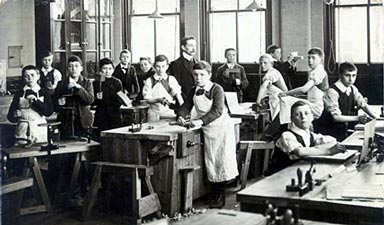
Redlands School class circa 1910 (reproduced by permission of Reading Library Service)
The County Borough became the local education authority in 1903, taking over the School Board. It also took over local welfare provision and health care from the Poor Law Guardians in 1930. It now ran virtually all the local public services provided in the town.
And it became bigger. Not just in terms of population, but in land too. The Borough boundaries were significantly extended in 1911 when Tilehurst and Caversham (previously part of Oxfordshire) became part of Reading. The Borough’s boundaries remain largely unchanged from the 1911 extension.
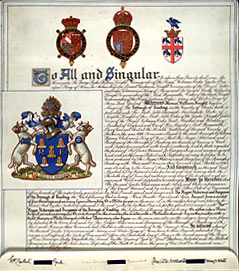
The new grant of arms to the County Borough of Reading 1953 (R/acc 7191.1)
The town still provides glimpses of the Council’s previous incarnations. There are the Abbey Ruins of its long departed landlord; High Bridge restored in 1787 by a Corporation keen to see trade flourish; the expression of Victorian civic pride through the Town Hall and a legacy of public undertakings from schools to the IDR. The Gildhall is now buried underneath the Oracle, with the modern shopping centre now maintaining a link to the merchant traders who started the town.
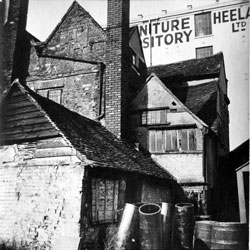
The Gildhall or Yield Hall shortly before its demolition circa 1935 (D/EX1722/14/3)
The old Borough lost its status and its independence in 1974, when like all boroughs it was abolished and replaced by a district council, sharing its responsibilities with a County Council. But the new Council was permitted to retain the arms, the title and the history of its predecessor.
Since 1998 it has been restored to its position as the sole local authority running the town, responsible for the provision of schools, social services, housing, roads and transport policy and a range of cultural services.
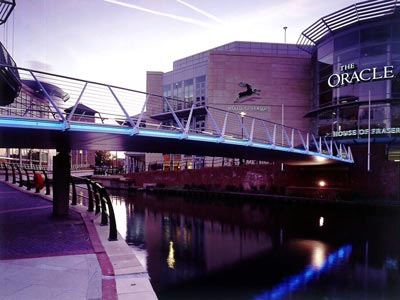
The Oracle Centre 2001 (reproduced by permission of The Oracle)
